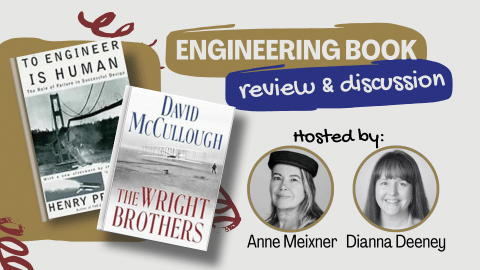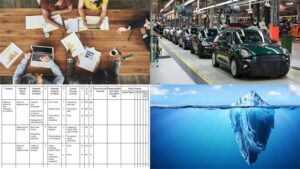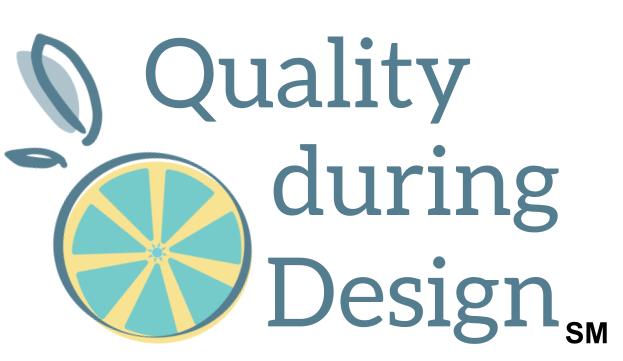Bridging Triumph and Trial: A Panel Discussion about Engineering with ‘To Engineer is Human’ and ‘The Wright Brothers’

Uncover the intricacies of engineering's past and present as we dissect To Engineer is Human and The Wright Brothers. Our collective expertise spans the gamut from semiconductor testing to biotechnology statistics, offering a rich tapestry of perspectives on these seminal works. This episode promises a journey through the shared trials and triumphs that shape our engineering landscape and a candid examination of the setbacks we seldom speak about.
Their wish for listeners is to gain different perspectives and to get inspired toward action: to try something new, read one of the books, or make new connections with others.
The episode isn't complete without their review of the books that sparked this enriching dialogue. You'll hear why "The Wright Brothers" and "To Engineer is Human" scored high on our recommendation list for anyone keen on understanding the essence of engineering, from the glory of breakthroughs to the wisdom found in failures. Join us for this episode, where we bridge the divide between historical achievement and contemporary challenges in the ever-evolving world of STEM.
This panel discussion about engineering and STEM originally aired on Linked-In Live on November 1, 2023.
About the Engineering Books Reviewed
To Engineer is Human by Henry Petroski is a book about how we learn from our mistakes to make better things and build a better world. Engineering is not just about applying science and mathematics, but also about making judgments and taking risks. Petroski writes about a number of case studies, including the collapse of the Tacoma Narrows Bridge, the Crystal Palace of the Great Exhibition of 1851, and the Brooklyn Bridge.
The Wright Brothers by David McCullough is a biography of Orville and Wilbur Wright, the two brothers who invented the airplane, and their sister, Katharine, who helped them grow their ideas into successes. The book tells the story of their lives, from their childhood in Dayton, Ohio, to their groundbreaking experiments at Kitty Hawk, North Carolina. It also looks at the early days of aviation, and the many challenges that the Wright family had to overcome.
About the Reviewers
Anne Meixner is a semiconductor test expert with 30 years’ experience as an engineer and technical leader. She founded The Engineers’ Daughter to consult on semiconductor testing and to contribute to engineers' career development.
Dr. Vaneeta Kaur Grover is the Director of CMC statistics at Seagen, a company that develops and commercializes transformative cancer medicines. She leads a group focused on applying statistics and data science to chemistry, manufacturing, and controls for biotechnology.
Dianna Deeney is an engineer and quality professional who helps product designers integrate quality and reliability engineering into their development process. She founded Quality during Design, an online resource for practical advice and problem-solving techniques.
Topics Discussed
1: How we get inspired, and the lessons learned from those inspirations
In both books, people created the impossible - with bridges and airplanes.
Petroski talks about how successful engineering designs stand as inspiration of what is possible. What gets hidden or forgotten are the challenges and lessons learned along the way. In contrast, failures are often clear in hindsight, and are difficult lessons learned because of loss. But those lessons are well-learned from the engineering community, and changes are adopted.
The Wright brothers looked at what other people were trying to engineer for humans to be able to fly (which had been a limited success). They decided that the focus on the machine and not controlling the machine had been a strategic error on other inventors’ efforts. They also did not openly criticize others’ works but kept to their own ideas and iterated on their own work. They shared their open-air trials with the local community and gave invited talks on their progress. But they were careful of what details to share.
Q: What gets in the way of us sharing lessons learned from a success? Is it the same challenge with how we learn from a failure, or different?
Q: How can STEM professionals best learn from today’s inspiring designs, in both how they work well and how they fail? Where are you finding stories?
2: Due diligence in STEM
Petroski challenges the traditional view of engineers as rational and infallible. They’re portrayed as being humans inspired toward innovation. They may base work on successes of others, and failures are a reminder that they innovated too far too quickly. Failure investigations help all engineers “understand more fully what some apparently did not.”
The Wright’s initial trials were based on the experts before them, and they took a wide approach to gathering what was known about flight at the time. Through their first trials they realized that the experts were wrong. They needed to abandon their initial assumptions of what would work and restart from the beginning on their own.
Q: “We stand on the shoulders of giants.” Do you think it is more difficult or easier to practice due diligence with ideas today compared to the early 1900s? Why?
3: Transfer of knowledge from other disciplines
In To Engineer is Human, the Tacoma Narrows Bridge “undulated dramatically”. It failed from a cross-wind while a scale model was being tested at the University of Washington to figure out what could be done to stabilize it. It was an expert in aeronautical engineering that identified the problem and a mathematical representation - as a slender bridge deck acting like an airplane wing in the wind.
The Wright Brothers’ skills and knowledge of bicycle riding and machines transferred into their development of the airplane.
Q: Do you find that your varied interests help you to be a better STEM professional? What are examples of some skills that you transfer to your current challenges?
4: How we iterate in STEM: from small scale to large, and test-iterate cycles
The Crystal Palace in To Engineer is Human was a current-day marvel at the Great Exhibition in London, 1851. Its first conception was from a small greenhouse that was built to house a delicate plant. Iterations of those first, smaller designs, were used to build the final, large structure. Bridge building design also grew from smaller bridges, taking what worked on a small scale and adopting it to a larger scale.
The Wright brothers did engineering testing and built their own test fixtures and equipment. They also did many test-iteration cycles with prototype airplanes. Their iterations were done within the few months of the year that were acceptable, weatherwise, to do their test flights. So, their window of iterations was short.
Q: Is your industry more specific to one: using the small-to-large scale iterations or test-iteration cycles?
Q: Some producers release their test-iteration products to get field use (customer use and feedback) as part of their design iterations. Is this a reasonable and sustainable activity?
Questions to consider for yourself
STEM and Culture
The Brooklyn Bridge and the Crystal Palace in To Engineer is Human was supported by some groups, but challenged by many others. Bridges were seen as a necessary improvement, but also very dangerous and not readily accepted by the public. The Crystal Palace was seen as a marvel, but not necessary.
The Wright Brothers’ flights were dismissed by many in the world as “impossible”, and some groups didn’t even give them their time to demonstrate their work. France provided a better environment for demonstrating their success with the airplane than the US.
Q: How often do you think culture plays a role in today’s STEM inventors’ plans: just as much as the projects in the books or less?
Q: With today’s connected world, can we more easily find the people needed to support a STEM project compared to the projects in the books?
What to do next?
Read the books yourself and then revisit this episode to see how your ideas align with the reviewers.
Consider hosting your own engineering book review and discussion about these books with the people you know, using the same prompts. What new ideas or inspirations will you discover?
Other podcast episodes you may like:
From "Fall-Through" to "Follow-Through": A Proactive Strategy for Design
Brainstorming within Design Sprints
Need to innovate? Stop brainstorming and try a systematic approach.

